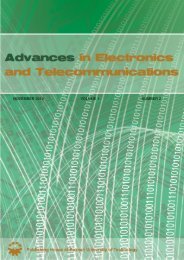channel - Advances in Electronics and Telecommunications
channel - Advances in Electronics and Telecommunications
channel - Advances in Electronics and Telecommunications
You also want an ePaper? Increase the reach of your titles
YUMPU automatically turns print PDFs into web optimized ePapers that Google loves.
ADVANCES IN ELECTRONICS AND TELECOMMUNICATIONS, VOL. 1, NO. 1, APRIL 2010 67<br />
High-Level Design Methodology for Ultra-Fast<br />
Software Def<strong>in</strong>ed Radio Prototyp<strong>in</strong>g on<br />
Heterogeneous Platforms<br />
Abstract—The design of Software Def<strong>in</strong>ed Radio (SDR) equipments<br />
(term<strong>in</strong>als, base stations, etc.) is still very challeng<strong>in</strong>g. We<br />
propose here a design methodology for ultra-fast prototyp<strong>in</strong>g<br />
on heterogeneous platforms made of GPPs (General Purpose<br />
Processors), DSPs (Digital Signal Processors) <strong>and</strong> FPGAs (Field<br />
Programmable Gate Array). Ly<strong>in</strong>g on a component-based approach,<br />
the methodology ma<strong>in</strong>ly aims at automat<strong>in</strong>g as much<br />
as possible the design from an algorithmic validation to a<br />
multi-process<strong>in</strong>g heterogeneous implementation. The proposed<br />
methodology is based on the SynDEx CAD design approach,<br />
which was orig<strong>in</strong>ally dedicated to multi-GPPs networks. We show<br />
how this was changed so that it is made appropriate with an<br />
embedded context of DSP. The implication of FPGAs is then<br />
addressed <strong>and</strong> <strong>in</strong>tegrated <strong>in</strong> the design approach with very little<br />
restrictions. Apart from a manual HW/SW partition<strong>in</strong>g, all other<br />
operations may be kept automatic <strong>in</strong> a heterogeneous process<strong>in</strong>g<br />
context. The targeted granularity of the components, which are<br />
to be assembled <strong>in</strong> the design flow, is roughly the same size as<br />
that of a FFT, a filter or a Viterbi decoder for <strong>in</strong>stance. The<br />
re-use of third party or pre-developed IPs is a basis for this<br />
design approach. Thanks to the proposed design methodology it<br />
is possible to port “ultra” fast a radio application over several<br />
platforms. In addition, the proposed design methodology is not<br />
restricted to SDR equipment design, <strong>and</strong> can be useful for<br />
any real-time embedded heterogeneous design <strong>in</strong> a prototyp<strong>in</strong>g<br />
context.<br />
Index Terms—Software-def<strong>in</strong>ed radio, design methodology,<br />
heterogeneous platform, cross-layer design<br />
Christophe Moy <strong>and</strong> Mickaël Raulet<br />
I. INTRODUCTION<br />
THIS paper proposes a method that meets most of the<br />
requirements associated with the design of Software-<br />
Def<strong>in</strong>ed Radio (SDR) equipments. SDR related research aims<br />
at <strong>in</strong>vestigat<strong>in</strong>g all the topics that can help improv<strong>in</strong>g future<br />
radio systems technologies [1], [2], [3]. In this paper, we<br />
address the particular issue of SDR equipments design, which<br />
is still a very open subject. This topic is also very similar to any<br />
real-time embedded heterogeneous design issue. SDR design<br />
is <strong>in</strong>deed a co-design issue, which is not restricted to SDR,<br />
<strong>and</strong> concerns most of the embedded real-time equipments. If<br />
we could discrim<strong>in</strong>ate SDR from other equipment categories,<br />
we could say that SDR br<strong>in</strong>gs the flexibility paradigm to its<br />
height. That is why SDR equipments are expected to be made<br />
of various flexible process<strong>in</strong>g components, such as DSPs,<br />
GPPs, FPGAs <strong>and</strong> ASICs. Moreover, the flexibility is not only<br />
C. Moy is with SUPELEC/IETR, Rennes, France. (phone: +33 2 99 84 45<br />
84; fax: +33 2 99 84 45 99; e-mail: christophe.moy@supelec.fr)<br />
M. Raulet is with INSA/IETR, Image Group, Rennes, France. (e-mail:<br />
mickael.raulet@<strong>in</strong>sa-rennes.fr).<br />
considered at design time <strong>in</strong> SDR systems, but also at runn<strong>in</strong>g<br />
time. An SDR system consequently should be capable of tak<strong>in</strong>g<br />
benefit from the potential reconfigurability of the flexible<br />
components it is made of. This implies an appropriate design<br />
methodology, which transforms this potential reconfigurability<br />
<strong>in</strong>to an effective flexibility at run-time [4].<br />
The existence of a reconfiguration management architecture<br />
at equipment level, <strong>and</strong> at <strong>in</strong>frastructure system level [5] must<br />
not be forgotten. However reconfiguration management is not<br />
directly <strong>in</strong>cluded <strong>in</strong> the design methodology <strong>in</strong> this paper, but<br />
we expla<strong>in</strong> how this approach is compatible with its <strong>in</strong>sertion,<br />
<strong>in</strong> a future step. This assertion relies on our deep experience<br />
<strong>in</strong> reconfiguration management issues [6] <strong>and</strong> [7]. Reves et al.<br />
<strong>in</strong> [8] are also <strong>in</strong>vestigat<strong>in</strong>g ways to resolve these problems <strong>in</strong><br />
a similar spirit.<br />
There are several ways to consider SDR design. The approaches<br />
can be divided <strong>in</strong>to two dist<strong>in</strong>ct categories:<br />
- fast prototyp<strong>in</strong>g for lab demos,<br />
- commercial equipments design.<br />
Time has not come yet to consider the second category<br />
as a realistic option. Only sub-parts of the design flow are<br />
achieved <strong>and</strong> they are ma<strong>in</strong>ly those used <strong>in</strong> a prototyp<strong>in</strong>g<br />
flow. We particularly address <strong>in</strong> this paper the fast prototyp<strong>in</strong>g<br />
issue from algorithmic simulation to multi-process<strong>in</strong>g heterogeneous<br />
implementation. Usual heterogeneous embedded<br />
design approaches mix several <strong>in</strong>dependent tools dedicated to<br />
hardware or software, which require long efforts <strong>and</strong> can cause<br />
errors. In order to tackle the issue, we act at a higher level<br />
so that automation <strong>and</strong> acceleration are implied <strong>in</strong> the design<br />
process.<br />
The paper is organized as follows. The requirements of<br />
heterogeneous co-design, as addressed <strong>in</strong> the SDR area, are<br />
expla<strong>in</strong>ed <strong>in</strong> section II. But there are many ways to address<br />
the concerned co-design issue. This is expla<strong>in</strong>ed <strong>in</strong> section<br />
III of this paper <strong>and</strong> section IV extracts the ma<strong>in</strong> features of<br />
a realistic flow. Section V suggests a possible <strong>in</strong>stantiation<br />
of this flow <strong>and</strong> illustrates how the suggested heterogeneous<br />
approach meets section III requirements. F<strong>in</strong>ally, SDR design<br />
examples based on the proposed approach are given <strong>in</strong> VI,<br />
before draw<strong>in</strong>g some conclusions.<br />
II. SDR DESIGN ISSUES<br />
SDR design is very challeng<strong>in</strong>g <strong>and</strong> there is not any s<strong>in</strong>gle<br />
solution which covers all radio eng<strong>in</strong>eers’ expectations. This<br />
section <strong>in</strong>tends to list the ma<strong>in</strong> issues to be resolved. It







